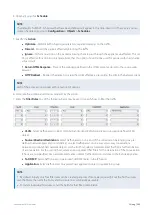
Exinda Network Orchestrator
3 Using
|
301
Screenshot 135: Single Queue Mode
Multi-Queue Mode
The multi-queue mode uses one policy queue per CPU where the flows of a given virtual circuit are divided evenly
among the policy queues. This eliminates the cross processor locking of global memory by distributing the policy
queues among the processors. Each flow within each policy is handled by a single processor.
Each CPU processes 1/N of each virtual circuit’s traffic, where N is the number of CPUs. That is, if the virtual circuit is
specified in the Optimizer as having 10 Mbps bandwidth, in an appliance with four CPUs, each CPU policy queue will be
allowed 10 Mbps/4 = 2.5 Mbps per CPU. In order to have even distribution, it assumes multiple flows that can be
distributed among the N CPUs. This queueing method is not good for environments where customers validate the
amount of bandwidth they receive by sending a single long flow through their virtual circuit.
In this case, the flow is handled by a single CPU and the other CPUs are idle. It then appears that they are getting 1/N of
the amount of traffic that they are expecting even though in more realistic use of the network, where the flows can be
distributed more evenly, they will get the appropriate amount of bandwidth.
Содержание EXNV-10063
Страница 98: ...Exinda Network Orchestrator 2 Getting started 98 6 Click New The New Virtual Hard Disk wizard opens ...
Страница 99: ...Exinda Network Orchestrator 2 Getting started 99 7 Select VHDX as the Disk Format type and click Next ...
Страница 130: ...Exinda Network Orchestrator 2 Getting started 130 Screenshot 35 The life cycle of configuration status ...
Страница 369: ...Exinda Network Orchestrator 4 Settings 369 ...
Страница 411: ...Exinda Network Orchestrator 4 Settings 411 Screenshot 168 P2P OverflowVirtualCircuit ...
Страница 420: ...Exinda Network Orchestrator 4 Settings 420 Screenshot 175 Students OverflowVirtualCircuit ...
Страница 451: ...Exinda Network Orchestrator 4 Settings 451 ...
















































